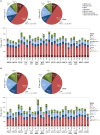Seed Yield and Nitrogen Efficiency in Oilseed Rape After Ammonium Nitrate or Urea Fertilization
- PMID: 33584751
- PMCID: PMC7874180
- DOI: 10.3389/fpls.2020.608785
Seed Yield and Nitrogen Efficiency in Oilseed Rape After Ammonium Nitrate or Urea Fertilization
Abstract
In agricultural plant production, nitrate, ammonium, and urea are the major fertilized nitrogen forms, which differ in root uptake and downstream signaling processes in plants. Nitrate is known to stimulate cytokinin synthesis in roots, while for urea no hormonal effect has been described yet. Elevated cytokinin levels can delay plant senescence favoring prolonged nitrogen uptake. As the cultivation of winter oilseed rape provokes high nitrogen-balance surpluses, we tested the hypotheses whether nitrogen use efficiency increases under ammonium nitrate- relative to urea-based nutrition and whether this is subject to genotypic variation. In a 2-year field study, 15 oilseed rape lines were fertilized either with ammonium nitrate or with urease inhibitor-stabilized urea and analyzed for seed yield and nitrogen-related yield parameters. Despite a significant environmental impact on the performance of the individual lines, which did not allow revealing consistent impact of the genotype, ammonium nitrate-based nutrition tended to increase seed yield in average over all lines. To resolve whether the fertilizer N forms act on grain yield via phytohormones, we collected xylem exudates at three developmental stages and determined the translocation rates of cytokinins and N forms. Relative to urea, ammonium nitrate-based nutrition enhanced the translocation of nitrate or total nitrogen together with cytokinins, whereas in the urea treatment translocation rates were lower as long as urea remained stable in the soil solution. At later developmental stages, i.e., when urea became hydrolyzed, nitrogen and cytokinin translocation increased. In consequence, urea tended to increase nitrogen partitioning in the shoot toward generative organs. However, differences in overall nitrogen accumulation in shoots were not present at the end of the vegetation period, and neither nitrogen uptake nor utilization efficiency was consistently different between the two applied nitrogen forms.
Keywords: ammonium nitrate; cytokinin translocation; nitrogen partitioning; nitrogen uptake; nitrogen uptake efficiency; nitrogen use efficiency; rapeseed; urea.
Copyright © 2021 Heuermann, Hahn and von Wirén.
Conflict of interest statement
HH was employed by company SKW Stickstoffwerke Piesteritz GmbH. The remaining authors declare that the research was conducted in the absence of any commercial or financial relationships that could be construed as a potential conflict of interest.
Figures



References
-
- Andrews M. (1986). The partitioning of nitrate assimilation between root and shoot of higher plants. Plant Cell Environ. 9 511–519.
-
- Barneix A. J., Causin H. F. (1996). The central role of amino acids on nitrogen utilization and plant growth. J. Plant Physiol. 149 358–362. 10.1016/s0176-1617(96)80134-9 - DOI
LinkOut - more resources
Full Text Sources
Other Literature Sources
Research Materials

